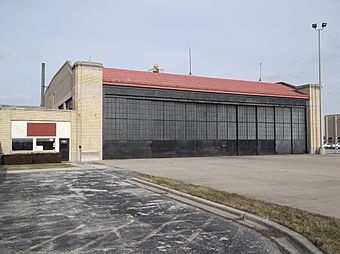Lansing Municipal Airport facts for kids
Quick facts for kids
Lansing Municipal Airport
|
|||||||||||||||
|---|---|---|---|---|---|---|---|---|---|---|---|---|---|---|---|
| Summary | |||||||||||||||
| Airport type | Public | ||||||||||||||
| Owner | Village of Lansing | ||||||||||||||
| Serves | Chicago, Illinois | ||||||||||||||
| Location | Lansing, Illinois | ||||||||||||||
| Opened | April 1940 | ||||||||||||||
| Elevation AMSL | 620 ft / 189 m | ||||||||||||||
| Map | |||||||||||||||
| Lua error in Module:Location_map at line 420: attempt to index field 'wikibase' (a nil value). | |||||||||||||||
| Runway | |||||||||||||||
|
|||||||||||||||
| Statistics (2004) | |||||||||||||||
|
|||||||||||||||
|
Source: Federal Aviation Administration
|
|||||||||||||||
Lansing Municipal Airport is a public airport located about 21 miles (34 km) south of Chicago, in Lansing, Illinois. It is owned by the Village of Lansing. This airport helps people travel and move goods around.
Most airports in the U.S. use a special three-letter code for both the FAA and the IATA. Lansing Municipal Airport has the code IGQ from the FAA. However, it does not have a code from the IATA.
Contents
Airport Features and Airplanes
Lansing Municipal Airport covers a large area of 650 acres (260 ha). It has two main runways where planes take off and land. Both runways are paved with asphalt.
- One runway is called 9/27. It is 3,395 feet (1,035 meters) long and 75 feet (23 meters) wide.
- The other runway is called 18/36. It is 4,002 feet (1,220 meters) long and 75 feet (23 meters) wide.
This airport also has a special base for blimps! These blimps are like giant balloons that float in the sky. About one-fourth of the blimps you see flying over Chicago sports events come from here.
In 2004, the airport had 54,000 aircraft operations. This means planes took off or landed about 147 times each day. Most of these flights (91%) were for general aviation, which means private planes or small business flights. The other 9% were air taxi flights, which are like small charter flights. In 2016, 143 aircraft were based at this airport. These included:
- 113 single-engine planes
- 15 multi-engine planes
- 5 jet planes
- 9 helicopters
- 1 ultralight aircraft (very light planes)
Ford Hangar at Lansing Municipal Airport
|
Ford Airport Hangar
|
|

Ford Hangar in May 2012
|
|
| Location | 3250 Bob Malkas Drive Lansing, Illinois |
|---|---|
| Built | 1926 |
| Architect | Albert Kahn |
| NRHP reference No. | 85001009 |
| Added to NRHP | May 9, 1985 |
The Ford Hangar is a very old and important building at Lansing Municipal Airport. It was built starting in 1926 and finished in early 1927. In 1985, it was added to the National Register of Historic Places. This means it is a special building that should be protected because of its history.
Why Was the Ford Hangar Built?
The famous car maker, Henry Ford, had this hangar built. He wanted it to be a place where his company could make and show off their Ford Tri-Motor airplanes. These were some of the first successful passenger airplanes.
In 1923, Henry Ford bought 1400 acres of land in Lansing. He planned to build an airport there to connect Chicago with his factories in Detroit. Work on clearing the land for the hangar began on June 1, 1926. The goal was for the hangar to hold three of Ford's Tri-Motor planes.
Special Design of the Hangar
Albert Kahn was the main architect for Henry Ford. He designed the Ford Hangar. Kahn wanted to fix problems that many early hangars had. He made the Ford Hangar very innovative for its time.
Older hangars were often poorly designed, temporary, and dark. Kahn made sure the Ford Hangar was better by including three special features:
- Open Interior: He used a building method called "cantilevered construction." This allowed the inside of the building to be open without needing many columns to hold up the roof. This also helped reduce wind pressure on the building.
- Easy-to-Move Doors: The hangar has large doors on its north and south sides. Kahn designed them so that just one person could easily move them. They run on wheels inside the building. This meant the doors could be opened to any length, no matter the wind or weather.
- Natural Light: Kahn also wanted the building to have lots of natural light. He added five large window openings, each about 15 by 18 feet. When these windows and the sliding doors were open, about 40% of the hangar's floor area could get natural light.
Hangar's History and Future
Henry Ford's plans for building Tri-Motor planes were affected by the Great Depression. This was a time when the economy was very bad. By July 1932, Ford stopped making airplanes. He then rented the airport land and the hangar to other people.
In 1976, the Village of Lansing bought the hangar and the airport. They did this to get money from the government to help improve the airport. The hangar was used for its original purpose until 2011. Then, it was emptied so that it could be preserved. Today, people are working to restore the building to look like it did when it was first built.
- Resources for this airport:
- FAA airport information for IGQ
- AirNav airport information for KIGQ
- FlightAware airport information and live flight tracker
- NOAA/NWS latest weather observations
- SkyVector aeronautical chart, Terminal Procedures


